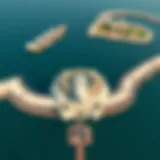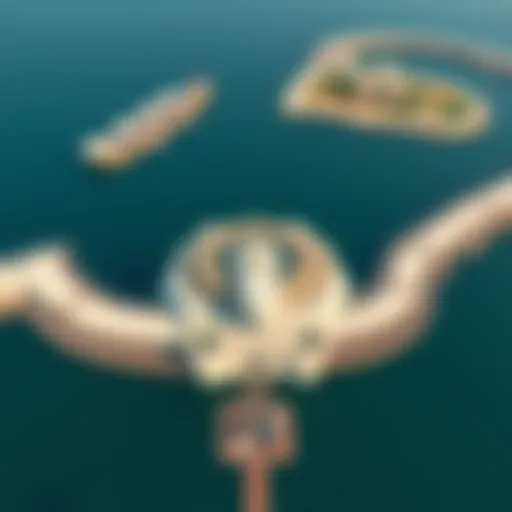Discovering Al Fahidi: A Journey Through Dubai's History
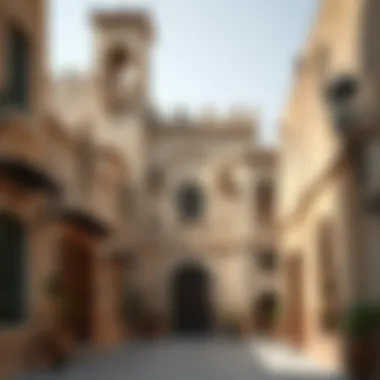

Intro
Nestled in the heart of Dubai, Al Fahidi Historical Neighbourhood stands as a testament to the emirate's rich heritage. This area, once a bustling center of commerce and trade, has transformed significantly over the years. Today, it serves not only as a cultural landmark but also as a vibrant community that fuses the old and the new.
Visitors often find themselves enchanted by its narrow winding lanes and traditional wind-tower buildings, which provide a stark contrast to the modern skyscrapers that dominate Dubai's skyline. As we dive deeper into the essence of Al Fahidi, readers will discover how this historical neighborhood is a valuable puzzle piece in understanding Dubai's evolution and modernization.
The significance of Al Fahidi transcends mere aesthetics; it represents the confluence of tradition and contemporary life. In fact, the area is a living museum of sorts, inviting not just tourists, but also investors, property managers, and developers to explore its multifaceted offerings. Whether one is interested in the architectural charm or in lucrative investment opportunities, Al Fahidi has something for everyone.
Through this exploration, we'll also gain insights into current trends in Dubai's real estate market, shedding light on how neighborhoods like Al Fahidi fit into the grander scheme of urban development. It's a complex interplay between preserving the past and accommodating modern needs, which merits a closer look.
Let us embark on this journey together as we uncover the layers of history, culture, and real estate potential waiting to be discovered in Al Fahidi.
Prolusion to Al Fahidi
Al Fahidi Historical Neighbourhood serves as a living, breathing testament to Dubai's rich past. This area, often overlooked in the rush of modern development, presents a unique opportunity for visitors, investors, and history enthusiasts alike to dive into the cultural tapestry that shapes the emirate today. Exploring Al Fahidi offers insights into the traditional lifestyle of the Emirati people, showcasing art, craft, and architecture that reveal stories from centuries past.
The value of understanding Al Fahidi goes beyond curiosity; it’s insightful for investors and property managers aiming to promote sustainable growth while respecting heritage. An informed interest in this historical site can drive demand for future real estate development, blending modern amenities with the charm of traditional designs.
Defining Al Fahidi's Historical Importance
Al Fahidi is not just a collection of old buildings; it is a gateway into Dubai’s history. Established in the late 19th century, this neighbourhood was pivotal for trade and commerce, housing merchants and craftsmen who played significant roles in the regional economy. The neighborhood’s layout, featuring narrow lanes and labyrinth-like alleys, was specifically designed for optimal ventilation and shade, reflecting architectural intimacy and functionality in an arid climate.
Each structure in Al Fahidi silently speaks volumes about the craftsmanship and indigenous building techniques used. For example, the use of coral stones and gypsum demonstrates how residents adapted to their environment. Importantly, Al Fahidi hosts some of Dubai's earliest wind towers, which signify advanced climate adaptation methods before modern air conditioning became prevalent. Emphasizing these historical nuances not only elevates the profile of Al Fahidi but also invites thoughtful investment in preservation initiatives that cater to today’s economic realities.
Overview of Dubai's Historical Evolution
Dubai's transformation from a small fishing village to a bustling metropolis is nothing short of extraordinary. Throughout the 20th century, as the oil boom unfolded, the emirate's landscape altered dramatically. The introduction of oil revenues has led to exponential urban growth, resulting in high-rises sprouting across the skyline, often at the cost of cultural heritage.
Nonetheless, sites like Al Fahidi maintain a bridge to the past, allowing individuals to grasp how the nation has evolved. Several factors characterized this transition:
- Economic Shifts: Initial reliance on fishing and pearl diving transitioned to trade and then later to oil and tourism-driven economies.
- Cultural Influences: The encounter with different cultures through trade routes infused Dubai with a diverse range of traditions, visible in local cuisine, architecture, and social practices.
- Urban Planning: The rapid urbanization has created challenges for historical preservation, making areas like Al Fahidi critical for balance between growth and heritage conservation.
Cultural Significance of Al Fahidi
Al Fahidi is not just a collection of old buildings; it’s a time capsule that contains the essence of Emirati culture and history. This area stands as a testament to the resilience and identity of its people. Here, the architectural styles, community practices, and cultural rites of the past are preserved, allowing the present and future generations to connect with their roots.
In the heart of Dubai, Al Fahidi serves as a vibrant reminder of the UAE’s heritage. Its narrow lanes, traditional wind towers, and mud-brick structures reflect a way of life that has changed dramatically over the years. Visitors walking through its streets find themselves immersed in stories of life before the skyscrapers and luxury developed across the emirate. The cultural significance of Al Fahidi goes beyond historical curiosity; it is crucial for real estate investors, property managers, and developers to recognize it as an area that fosters a unique blend of tradition and modernity.
Preserving Emirati Heritage
The preservation of Emirati heritage within Al Fahidi is paramount to maintaining the identity of not only the neighborhood but also the country. This historical area represents the core values, customs, and traditions of the Emirati people. It showcases architectural styles that are adapted to the desert climate, incorporating features such as wind towers that naturally cool the buildings.
Efforts to preserve Emirati heritage are evident in various initiatives:
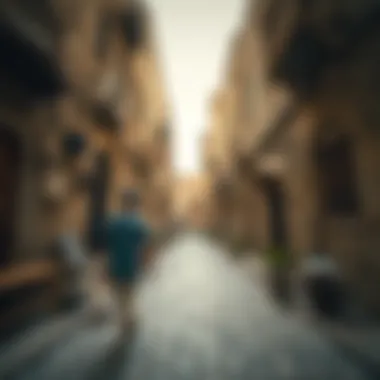

- Restoration Projects: These projects aim to restore the original structures, ensuring that they remain intact for future generations.
- Cultural Festivals: Events like the Dubai Art Season and other local festivals often showcase Emirati arts, music, and dance. These not only celebrate the culture but educate visitors about its significance.
- Museum Engagement: Institutions such as the Dubai Museum, located right within Al Fahidi, serve as educational platforms, sharing stories and artifacts that highlight the region's history.
Efforts like these attract numerous tourists, providing a lifeline to local businesses while reinforcing identity. Community engagement further strengthens the connection to heritage, fostering pride in the traditional values.
Art and Artisan Crafts in Al Fahidi
Al Fahidi is also bursting with creativity, particularly in its art and artisan crafts. The neighborhood functions as a canvas where traditional Emirati crafts are still alive and kicking. These artisans are not just preserving their heritage; they’re breathing new life into it by adapting their work to contemporary tastes. From intricate textiles to eye-catching pottery, the craftsmanship here is a showcase of what Emirati culture offers.
Art galleries dot the streets and exhibit local talent, often featuring works that represent daily life, history, and future aspirations.
Some key elements include:
- Silk Weaving and Calligraphy: Traditional crafts have found new appreciation, with workshops teaching new generations these intricate skills.
- Local Artisans Market: Regular markets highlight local crafts, providing exposure and economic benefits to artisans.
- Collaboration with International Artists: These interactions foster cultural exchange that enriches both the local and global art scene.
Through these initiatives, Al Fahidi not only serves as a hub for craft preservation but also promotes the economic viability of its artisans. This dynamic fosters a connection between visitors and the local community, ultimately enriching the experience of those wishing to invest or reside within the historical charm of Al Fahidi.
Architectural Style and Features
The architectural landscape of Al Fahidi Historical Neighbourhood serves as a canvas showcasing the region's deep-rooted connection to its past. Understanding its architectural style is more than an appreciation for aesthetics. It's about unlocking the stories embedded in the walls, the practices bygone eras used to create lasting structures. This section walks the reader through some critical architectural features and their relevance in maintaining the cultural tapestry of Dubai.
Traditional Wind Towers and Their Functionality
One striking feature that distinguishes Al Fahidi's architecture is the traditional wind towers, locally known as barjeel. These ancient structures are much more than decorative elements; they are a brilliant demonstration of early Arabian ingenuity in climate management. Positioned at various points atop the buildings, these towers catch the wind sweeping off the Persian Gulf. This natural ventilation cools the air, making living spaces more comfortable during the scorching summer months.
Interestingly, the function of a wind tower goes beyond mere comfort. It speaks volumes about resourcefulness at a time when electricity was not an option. Houses boasting wind towers exhibit a communal awareness of environmental challenges. Their design, often featuring open slits facing the prevailing wind direction, ensures optimal airflow, thus showcasing Al Fahidi's architects as trailblazers in sustainable living.
Materials and Construction Techniques Used
The materials used in constructing Al Fahidi's historic homes showcase a profound respect for local environmental resources. Primarily, coral stones and mud bricks constitute the walls. Coral stone, sourced from the nearby coastline, offers both sturdiness and insulation, while mud bricks provide thermal properties. This strategic use of materials tells a story of adaptation to the harsh climate and availability of local resources.
Construction techniques have also evolved, reflecting changes in community needs while maintaining tradition. For instance, traditional plaster, known as khadra, was often used to finish outer walls and provide additional protection against the elements. It is also interesting to note that many homes incorporate intricately carved wooden doors and balconies, which not only add to the aesthetic beauty but also demonstrate the artisanship that characterizes Emirati culture.
The Evolution of Al Fahidi Communities
Al Fahidi Historical Neighborhood is not just a showcase of Dubai's architectural splendor; it is a living history that illustrates the evolution of its communities. The changes that have taken place over the years offer critical insights into how culture, society, and economy intertwine in the face of modernization. Understanding this evolution sheds light on the community dynamics that have both preserved and adapted Emirati heritage to contemporary life.
Demographic Changes Over the Years
Al Fahidi has seen a remarkable shift in its demographic landscape since its inception. Initially a settlement for traders and fishermen, the area attracted diverse populations from surrounding regions and beyond. As Dubai embarked on its journey of growth, the import of foreign labor changed the face of the community.
- Historical Roots: In the early days, Al Fahidi catered to Emiratis and neighboring tribes, fostering a tight-knit community centered around trade and the river.
- Modern Immigration Trends: The oil boom in the 1970s led to an influx of expatriates seeking opportunities, causing a significant demographic shift. The blend of cultures began to enrich the neighborhood, bringing in traditions, languages, and culinary influences from places like the Indian subcontinent, Europe, and beyond.
- Current Demographics: Today, Al Fahidi stands as a melting pot, with Emiratis, expatriates, and tourists co-inhabiting the space. This diversity is a double-edged sword; it enhances cultural exchange but also challenges the preservation of authentic Emirati identity.
It's crucial to note that while demographic shifts bring vibrancy, they can also impose certain challenges. Issues such as community fragmentation, cultural dilution, and housing pressures arise. Thus, understanding these dynamics helps local stakeholders in fostering a more integrated community spirit.
Community Initiatives and Engagement
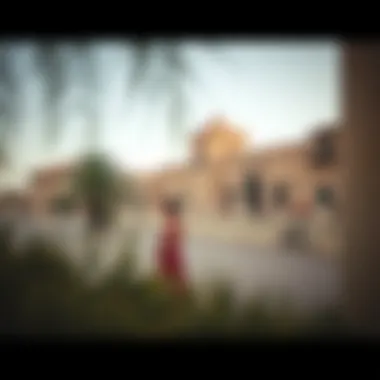

To navigate the complexities brought on by these demographic changes, various community-driven initiatives have taken root in Al Fahidi. These initiatives serve not only to engage residents but also to infuse life into the cultural fabric of the neighborhood.
- Heritage Events: Regular cultural festivals and art exhibitions encourage community participation and attract visitors. Local artists often showcase their work, providing a platform for traditional crafts while instilling a sense of pride among residents.
- Engagement Programs: Workshops focusing on traditional Emirati skills, such as pottery and weaving, are organized, allowing younger generations to connect with their roots.
"By engaging the community in preserving its traditions, Al Fahidi not only safeguards its heritage but also creates a sense of belonging among the diverse populations that now call it home."
- Collaborative Spaces: Initiatives aimed at creating co-working or cultural spaces enable dialogue and interaction between various community members. These spaces can facilitate networking, idea-sharing, and even entrepreneurial ventures, thereby invigorating the local economy.
The evolution of Al Fahidi communities is a testament to the resilience and adaptability of its people. By blending old traditions with new influences, the neighborhood continues to grow, presenting a model worth studying for future developments in Dubai and beyond.
Al Fahidi in the Context of Modern Dubai
Al Fahidi Historical Neighbourhood represents a unique intersection between Dubai's rich history and its vibrant modernity. As the city rapidly transforms into a global hub of trade and tourism, Al Fahidi serves as a vital reminder of the Emirate's cultural roots. It captures the essence of the past while integrating the conveniences of contemporary life.
Balancing Heritage and Modernity
In the heart of Dubai, there’s an ongoing effort to strike a balance between preserving Al Fahidi’s heritage and meeting the demands of modern urban life. The neighbourhood features traditional wind towers, an architectural style designed to provide cooling during the desert heat. These structures are more than just beautiful relics; they symbolize a lifestyle that harmonizes with nature.
However, this preservation does not mean standing still. New developments, such as art galleries and boutique hotels, embrace modern aesthetics without overshadowing historical significance. The notion is simple: keep the character of Al Fahidi alive, while enhancing its functionality to attract visitors and potential investors.
For property managers and investors, this balance presents numerous opportunities. Properties in Al Fahidi retain their charm while having modern amenities, attracting both tourists and locals interested in authentic Dubai experiences. Investors can see Al Fahidi as a prime area for revitalization efforts that capitalize on these historical edifices, turning them into profitable ventures that keep the tradition intact.
"Heritage is not just a part of the past; it’s a diversifier of future opportunities."
Transformative Projects and Their Impact
As Dubai continues to evolve, Al Fahidi is at the forefront of transformative projects designed to blend history with the future. Examples include the Dubai Design District and the Dubai Culture and Arts Authority initiatives which encourage public engagement with the heritage of the area. These projects focus not only on the preservation of physical spaces but also on fostering a new generation's appreciation for Emirati culture.
The impact of such projects is multi-faceted. On one hand, they draw increased foot traffic to Al Fahidi, benefitting local businesses—from artisan shops to cafés—helping them thrive in today’s economy. On the other hand, by shining a spotlight on this historical neighbourhood, they enhance its visibility on a global scale. This sort of visibility often intrigues international investors eyeing real estate opportunities.
For those interested in deeper engagement, sources like Dubai Culture provide valuable insights into ongoing projects in the area, as well as opportunities for community involvement.
Tourism and Economic Influence
The Al Fahidi Historical Neighbourhood plays a pivotal role in Dubai's tourism landscape, offering visitors a tangible link to the city's rich cultural roots. As one of the few areas where the past remains vibrantly alive amidst Dubai's rapid modernization, it serves both as a title card for the heritage of the Emirate and as a beacon for tourism-driven economic activity.
This neighbourhood attracts a diverse array of tourists, from history buffs eager to explore the Emirati lifestyle to curious travellers seeking a break from the bustling, futuristic cityscape. Within its narrow alleyways and traditional buildings, visitors are greeted by a wealth of experiences that embody the essence of Emirati culture.
Attractions within Al Fahidi
A plethora of attractions await all who venture into Al Fahidi. Notable highlights include:
- Dubai Museum: Housed in the Al Fahidi Fort, it showcases artifacts and exhibits that narrate the story of Dubai's transformation from a modest fishing village to a global metropolis.
- Sheikh Mohammed Centre for Cultural Understanding: This center offers cultural meals and informative tours that allow visitors to engage directly with Emirati traditions and values, fostering a bridge of understanding.
- Art Galleries and Studios: Numerous spaces showcase the local art scene, featuring both contemporary pieces and traditional crafts. These include the XVA Gallery and the Alserkal Cultural Foundation. An artful stroll through the neighbourhood reveals how Dubai's creative spirit intertwines with its heritage.
Overall, these attractions not only provide entertainment for visitors but also contribute significantly to the local economy, creating jobs and encouraging entrepreneurial ventures. Al Fahidi's charm lies in its ability to merge historical allure with an evolving artistic scene, enticing both local and international visitors.


Impact on Local Businesses and Investments
The economic impact of tourism in Al Fahidi extends beyond mere foot traffic; it catalyzes local businesses and stimulates investments. Small shops selling handcrafted textiles, traditional spices, and artworks thrive in this environment, drawing in tourists eager to take home memorable keepsakes. Many of these businesses are family-owned, preserving traditions while also adapting modern practices to meet the demands of a diverse clientele.
Investors too are taking notice. As the neighbourhood gains recognition as a cultural hotspot, property values have started to trend upward. This is especially attractive for real estate developers looking to invest in the restoration and enhancement of properties that respect the integrity of the architectural style while integrating modern amenities.
- Investable Opportunities:
- Revitalization projects focusing on boutique hotels and cafes that echo the area's historical character.
- Collaborative spaces for artists and entrepreneurs that encourage a creative community.
- Cultural events and festivals can further boost local business, fostering community engagement while enhancing visitor experiences.
The combination of tourism and economic growth creates a symbiotic relationship, where local businesses benefit from increased tourist interest and residents enjoy an enhanced community environment. In essence, Al Fahidi not only preserves the past; it actively shapes a resilient, economically vibrant future.
Future Prospects for Al Fahidi
As Al Fahidi continues to evolve, the future prospects of this cherished enclave hold much intrigue for a variety of stakeholders. Recognizing the delicate balance between preserving history and embracing modernity, the area offers unique opportunities and challenges that merit consideration from investors, developers, and community members alike.
Sustainability and Development Challenges
In today’s world, sustainability can’t just be an afterthought; it demands serious consideration, particularly in areas rich in cultural heritage like Al Fahidi. The challenge lies in ensuring that the rush of development does not drown out the whispers of history embedded within its walls.
When discussing sustainability, it’s vital to recognize that residents and visitors find beauty in Al Fahidi's charm, which is inherently tied to its preservation. This point is emphasized by:
"Harmony exists when modern needs align with historical respect; without it, we risk losing our collective identity."
Thus, developers should be mindful of the original architecture while integrating new technologies. Retrofitting existing buildings rather than tearing them down makes economic sense while staying true to the original aesthetic, allowing the area to thrive in a way that respects its roots.
- Eco-friendly Construction: Using sustainable materials and low-impact construction techniques can alleviate some environmental concerns.
- Community Involvement: Engaging community members in decision-making processes can ensure that developments do not alienate long-standing residents.
- Regulations: Striking a balance between planning regulations and the need for modern amenities is crucial. Local government policies must also incentivize sustainable practices.
As Al Fahidi prepares for future growth, the challenges surrounding sustainability must be met with innovative solutions to maintain the rich cultural tapestry that defines this neighbourhood.
Potential for Real Estate Investments
The real estate landscape in Al Fahidi is shifting, and with the right strategy and insight, opportunities abound for interested investors. With its unique blend of history and appeal, the neighbourhood is poised to capture the eyes of both local and international investors.
Investing in this area is more than just purchasing property; it’s about becoming part of a cultural narrative. Potential benefits include:
- Rising Tourism: With increased global interest in cultural tourism, Al Fahidi's historical significance draws visitors eager for an authentic experience. This patterns suggests higher property demand and rental yields.
- Government Initiatives: Dubai’s strategic vision often focuses on revitalizing historical areas. Don’t be surprised to see incentives appearing that favour development in culturally significant neighbourhoods like Al Fahidi.
- Networking Opportunities: Engaging with property managers and realtors familiar with the area’s nuances can provide insight into lucrative deals.
Ultimately, while risks are present, the future of Al Fahidi can be bright for investors willing to navigate the waters thoughtfully. By blending respect for history with modern demands, this neighbourhood can thrive economically while retaining its cultural heartbeat.
The End: Reflections on Cultural Heritage
The Al Fahidi Historical Neighbourhood stands as a timeless testament to Dubai's rich past and cultural value. By exploring its winding alleyways and traditional structures, one cannot help but appreciate the merging of history and modernity. Within this article, we've laid bare the myriad elements that weave Al Fahidi into the fabric of Dubai's identity—from its unique architectural style to the cultural significance that resonates in the heart of Emirati life.
Summary of Findings
In summarizing our exploration, several key points emerge:
- Historical Importance: Al Fahidi serves as a significant connector to Dubai's maritime roots and reflects the lifestyle of the local populace before the city's rapid development took place.
- Cultural Richness: The ample art galleries, museums, and craft shops maintain Emirati traditions while welcoming global influences, ensuring that the cultural vibrancy remains alive.
- Architectural Integrity: Structures featuring traditional wind towers highlight past building techniques adapted for climate, showcasing both functionality and aesthetic appeal.
- Community Dynamics: The ebb and flow of demographics create a colourful tapestry of what it means to live and work in a neighbourhood that embraces change yet safeguards history.
- Future Potential: The present-day significance of Al Fahidi in the realm of real estate hints at its economic relevancy, balancing growth with the preservation of cultural roots.
The Role of Al Fahidi in Dubai's Future
Looking ahead, the significance of Al Fahidi continues to evolve. As modern developments make their mark, the neighbourhood remains a focal point in the conversation about heritage versus advancement. Investors and developers often find value not just in the tangible buildings but also in the emotions tied to a place steeped in stories.
The potential for real estate growth intertwined with cultural preservation is palpable. Al Fahidi can become a model for other regions in Dubai, showing how embracing history can lead to successful investment opportunities. With initiatives promoting sustainability and community engagement, the neighbourhood can set the benchmark for future developments across the Emirates.


